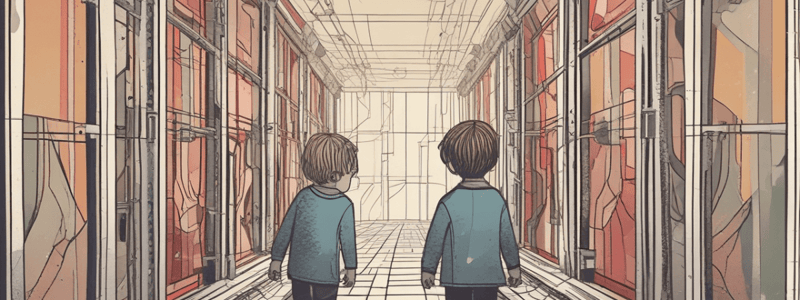Podcast
Questions and Answers
In Erikson's theory, the crisis during ______ is Trust Vs. Mistrust.
In Erikson's theory, the crisis during ______ is Trust Vs. Mistrust.
Infancy
The virtue developed from the crisis of Identity vs. Identity Confusion during adolescence is ______.
The virtue developed from the crisis of Identity vs. Identity Confusion during adolescence is ______.
Fidelity
During Young Adulthood, the major crisis according to Erikson is ______ vs. Isolation.
During Young Adulthood, the major crisis according to Erikson is ______ vs. Isolation.
Intimacy
The virtue of ______ is associated with the crisis of Generativity vs. Stagnation in Middle Adulthood.
The virtue of ______ is associated with the crisis of Generativity vs. Stagnation in Middle Adulthood.
The crisis of Autonomy vs. Shame and Doubt occurs during ______, specifically in Toddlerhood.
The crisis of Autonomy vs. Shame and Doubt occurs during ______, specifically in Toddlerhood.
Constructivism suggests that children actively ______ new understandings of the world based on their experiences.
Constructivism suggests that children actively ______ new understandings of the world based on their experiences.
Cognitive Growth occurs through 3 related processes: ______, Adaptation, and Equilibration.
Cognitive Growth occurs through 3 related processes: ______, Adaptation, and Equilibration.
Schemes refer to ways of ______ information about the world that govern the way the child thinks and behaves in a particular situation.
Schemes refer to ways of ______ information about the world that govern the way the child thinks and behaves in a particular situation.
Assimilation involves incorporating new information into existing ______ structures.
Assimilation involves incorporating new information into existing ______ structures.
Equilibration is when children want what they understand of the world to ______ what they observe around them.
Equilibration is when children want what they understand of the world to ______ what they observe around them.
The first stage of Jean Piaget's cognitive development is the ______ stage.
The first stage of Jean Piaget's cognitive development is the ______ stage.
Circular Reactions occur when an infant learns to reproduce events discovered by ______.
Circular Reactions occur when an infant learns to reproduce events discovered by ______.
Disequilibrium refers to ______ conflict.
Disequilibrium refers to ______ conflict.
Children shift from one stage of thought to the next using ______.
Children shift from one stage of thought to the next using ______.
Object ______: the realization that something continues to exist when it is out of sight
Object ______: the realization that something continues to exist when it is out of sight
In the Use of Reflexes stage, infants exercise their inborn ______ and gain some control over them.
In the Use of Reflexes stage, infants exercise their inborn ______ and gain some control over them.
Children under the age of ______ have difficulty grasping spatial relationships, according to the Dual Representation Hypothesis
Children under the age of ______ have difficulty grasping spatial relationships, according to the Dual Representation Hypothesis
During Primary Circular Reactions, infants begin to coordinate ______ information and grasp objects.
During Primary Circular Reactions, infants begin to coordinate ______ information and grasp objects.
The pre-operational stage lasts from ages ______ to ______
The pre-operational stage lasts from ages ______ to ______
In the Secondary Circular Reactions stage, infants learn about ______.
In the Secondary Circular Reactions stage, infants learn about ______.
Children begin to expand the use of ______ thought during the pre-operational stage
Children begin to expand the use of ______ thought during the pre-operational stage
The symbolic function stage involves using ______, numbers, or images as mental representations
The symbolic function stage involves using ______, numbers, or images as mental representations
In the Coordination of Secondary Schemes stage, infants can ______ events.
In the Coordination of Secondary Schemes stage, infants can ______ events.
Deferred Imitation occurs when children imitate an action at some point after ______ it
Deferred Imitation occurs when children imitate an action at some point after ______ it
Infants use trial and error to solve problems during the ______ Circular Reactions stage.
Infants use trial and error to solve problems during the ______ Circular Reactions stage.
In the intuitive thought stage, children begin to use logical and deductive ______
In the intuitive thought stage, children begin to use logical and deductive ______
Mental Combinations allow children to think about events and anticipate ______ without always resorting to action.
Mental Combinations allow children to think about events and anticipate ______ without always resorting to action.
During the symbolic function stage, children engage in pretend play, where they use an object to ______ something else
During the symbolic function stage, children engage in pretend play, where they use an object to ______ something else
Representational Ability refers to the ability to mentally represent objects and actions in ______.
Representational Ability refers to the ability to mentally represent objects and actions in ______.
According to Piaget, children under 18 months could not engage in ______ Imitation.
According to Piaget, children under 18 months could not engage in ______ Imitation.
During the Primary Circular Reactions stage, infants repeat pleasurable behaviors that first occur by ______.
During the Primary Circular Reactions stage, infants repeat pleasurable behaviors that first occur by ______.
The Formal Operational stage marks the highest level of cognitive development according to ______.
The Formal Operational stage marks the highest level of cognitive development according to ______.
Abstract thinking in this stage allows for reasoning and problem-solving beyond real-world ______.
Abstract thinking in this stage allows for reasoning and problem-solving beyond real-world ______.
Hypothetical-Deductive Reasoning allows for testing ______ and reaching conclusions through deductive reasoning based on abstract ideas.
Hypothetical-Deductive Reasoning allows for testing ______ and reaching conclusions through deductive reasoning based on abstract ideas.
Adolescents can use symbols to represent ideas and scenarios, encouraging ______ and exploring possibilities.
Adolescents can use symbols to represent ideas and scenarios, encouraging ______ and exploring possibilities.
David Elkind suggests that adolescents struggle to adapt to their new ______ and see themselves as others see them.
David Elkind suggests that adolescents struggle to adapt to their new ______ and see themselves as others see them.
Adolescents learn to analyze and synthesize information and reason ______.
Adolescents learn to analyze and synthesize information and reason ______.
Social awareness increases, but it can often be accompanied by feelings of self-consciousness and ______.
Social awareness increases, but it can often be accompanied by feelings of self-consciousness and ______.
The Formal Operational Stage marks a shift towards advanced cognitive abilities that allow for abstract thinking, sophisticated reasoning, and a deeper ______ of oneself and others.
The Formal Operational Stage marks a shift towards advanced cognitive abilities that allow for abstract thinking, sophisticated reasoning, and a deeper ______ of oneself and others.
In Stage 1: Obedience and Punishment Orientation, the child is good to avoid ______ because it equates they must have done something wrong.
In Stage 1: Obedience and Punishment Orientation, the child is good to avoid ______ because it equates they must have done something wrong.
In Stage 2: Individualism and Exchange, children conform to rules out of ______ and consideration of what others can do for them.
In Stage 2: Individualism and Exchange, children conform to rules out of ______ and consideration of what others can do for them.
In Stage 3: Good Interpersonal Relationship, approval of ______ is important to the child.
In Stage 3: Good Interpersonal Relationship, approval of ______ is important to the child.
In Stage 4: Maintaining Social Order, the child becomes aware of the rules of the ______.
In Stage 4: Maintaining Social Order, the child becomes aware of the rules of the ______.
Level II: Conventional Morality is also known as Morality of Conventional Role ______.
Level II: Conventional Morality is also known as Morality of Conventional Role ______.
In Level I: Preconventional Morality, Stage 2 is also referred to as ______ and Exchange.
In Level I: Preconventional Morality, Stage 2 is also referred to as ______ and Exchange.
The center circle of Bronfenbrenner's Ecological Model shows the ______, where the child has direct interactions with family, friends, and school.
The center circle of Bronfenbrenner's Ecological Model shows the ______, where the child has direct interactions with family, friends, and school.
From 7-10 years old, children are in transition showing some features of the first stage of moral reasoning and some stages of the ______.
From 7-10 years old, children are in transition showing some features of the first stage of moral reasoning and some stages of the ______.
Autonomous Morality becomes aware of the rules and laws created by ______.
Autonomous Morality becomes aware of the rules and laws created by ______.
In the Microsystem, the child has ______ contact with family and friends.
In the Microsystem, the child has ______ contact with family and friends.
In judging an action, children consider the intentions as well as the ______.
In judging an action, children consider the intentions as well as the ______.
The ______ shows the interaction between the home and school of the child, or family and peer groups.
The ______ shows the interaction between the home and school of the child, or family and peer groups.
The ______ is influenced by interactions within different environments.
The ______ is influenced by interactions within different environments.
In the Exosystem, extended ______ affects the child indirectly.
In the Exosystem, extended ______ affects the child indirectly.
In moral reasoning, people develop their own set of moral ______, which may or may not fit the law.
In moral reasoning, people develop their own set of moral ______, which may or may not fit the law.
At the Cosmic Stage, people consider the effect of their actions on the ______ as a whole.
At the Cosmic Stage, people consider the effect of their actions on the ______ as a whole.
Kohlberg's system is biased against ______ cultures.
Kohlberg's system is biased against ______ cultures.
Carol Gilligan proposed that women prioritize an 'ethics of ______'.
Carol Gilligan proposed that women prioritize an 'ethics of ______'.
According to Piaget, children in the Heteronomous Morality stage view justice and rules as ______ properties of the world.
According to Piaget, children in the Heteronomous Morality stage view justice and rules as ______ properties of the world.
Moral reasoning involves applying principles of ______ to moral issues.
Moral reasoning involves applying principles of ______ to moral issues.
During the Heteronomous Morality stage, children focus on the ______ of actions rather than the intentions.
During the Heteronomous Morality stage, children focus on the ______ of actions rather than the intentions.
______ justice is the concept that if a rule is broken, punishment will happen immediately.
______ justice is the concept that if a rule is broken, punishment will happen immediately.
The ______ incorporates social structures that affect one of the microsystems but do not contain the child.
The ______ incorporates social structures that affect one of the microsystems but do not contain the child.
The ______ consists of overarching cultural patterns such as dominant beliefs and economic systems.
The ______ consists of overarching cultural patterns such as dominant beliefs and economic systems.
The ______ consists of all environmental changes that occur over a lifetime, including major life transitions.
The ______ consists of all environmental changes that occur over a lifetime, including major life transitions.
According to Vygotsky, cognitive development is shaped by the sociocultural ______ in which it occurs.
According to Vygotsky, cognitive development is shaped by the sociocultural ______ in which it occurs.
Vygotsky placed emphasis on ______ as a crucial element in cognitive development.
Vygotsky placed emphasis on ______ as a crucial element in cognitive development.
The Zone of Proximal Development (ZPD) is the gap between what children can do by themselves and what they can accomplish with ______.
The Zone of Proximal Development (ZPD) is the gap between what children can do by themselves and what they can accomplish with ______.
When adults help direct and organize a child's learning, it is known as ______.
When adults help direct and organize a child's learning, it is known as ______.
Mary Ainsworth's ______ Situation is designed to assess attachment patterns between an infant and an adult.
Mary Ainsworth's ______ Situation is designed to assess attachment patterns between an infant and an adult.
Transduction is the mental linking of two events, whether or not there is logically a ______ relationship.
Transduction is the mental linking of two events, whether or not there is logically a ______ relationship.
The concept that people and things are basically the same even if they change in outward form, size, or appearance is called ______.
The concept that people and things are basically the same even if they change in outward form, size, or appearance is called ______.
______ is the tendency to attribute life to inanimate objects.
______ is the tendency to attribute life to inanimate objects.
The tendency to focus on one aspect of a situation and neglect others is known as ______.
The tendency to focus on one aspect of a situation and neglect others is known as ______.
Egocentrism is when young children center so much on their own ______ that they cannot take in another's.
Egocentrism is when young children center so much on their own ______ that they cannot take in another's.
The fact that two things remain equal if their appearance is altered, as long as nothing is added or taken away, is called ______.
The fact that two things remain equal if their appearance is altered, as long as nothing is added or taken away, is called ______.
______ is the awareness of the broad range of human mental states, such as beliefs, intents, and desires.
______ is the awareness of the broad range of human mental states, such as beliefs, intents, and desires.
At about 7 years of age, children enter the stage of ______ according to Jean Piaget.
At about 7 years of age, children enter the stage of ______ according to Jean Piaget.
Flashcards are hidden until you start studying
Study Notes
Constructivism
- Children construct new understandings of the world based on their experiences.
- Development is the product of children's attempts to understand and act upon their world.
- Begins with an inborn ability to adapt to the environment.
Cognitive Growth
- Occurs through 3 related processes: Organization, Adaptation, and Equilibration.
Organization
- Tendency to create categories.
- Schemes: ways of organizing information about the world that govern the way the child thinks and behaves in a particular situation.
Adaptation
- How children handle new information in light of what they already know.
- Assimilation: incorporating new information into existing cognitive structures.
- Accommodation: adjusting one's cognitive structures to fit the new information.
Equilibration
- Children want their understanding of the world to match what they observe around them.
- Provided rough benchmarks for what to expect of children at various ages and has helped educators design curricula appropriate to varying levels of development.
Sensorimotor Stage
- First stage of Jean Piaget's cognitive development.
- From birth to 2 years old.
- Circular Reactions: an infant learns to reproduce events originally discovered by chance.
- Schemes: actions or mental representations that can be performed on objects.
Psychosocial Theory by Erikson
- Crisis: Trust vs. Mistrust (Infancy, 0-1 year), Autonomy vs. Shame and Doubt (Toddlerhood, 1-3 years), Initiative vs. Guilt (Preschool Age, 3-6 years), and so on.
Cognitive Development Stages
- Stage 1: Use of Reflexes (Birth to 1 Month).
- Stage 2: Primary Circular Reactions (1-4 months).
- Stage 3: Secondary Circular Reactions (4-8 months).
- Stage 4: Coordination of Secondary Schemes (8-12 months).
- Stage 5: Tertiary Circular Reactions (12-18 months).
- Stage 6: Mental Combinations.
Representational Ability
- Ability to mentally represent objects and actions in memory, largely through symbols such as words, numbers, and mental pictures.
Object Permanence
- Realization that something continues to exist even when it's out of sight.
Pre-Operational Stage (Ages 2-7)
- Children expand on using symbolic thought.
- Use words, images, and drawings.
- Engage in egocentrism and magical beliefs.
Intuitive Thought (Ages 4-7)
- Children begin to use logical and deductive reasoning.
- Start asking questions.
- They can understand the symbols representing physical spaces.
Concrete Operational Stage
- At about 7 years of age, children enter the stage of Concrete Operations.
- Children can think logically because they can take multiple aspects of situations into account.
- Better understanding of spatial concepts, causality, and categorization.
Formal Operational Stage
- Abstract thinking allows for reasoning and problem-solving beyond real-world situations.
- Hypothetical-deductive reasoning: testing hypotheses and reaching conclusions through deductive reasoning based on abstract ideas.
- Symbolism: use symbols to represent ideas and scenarios, encouraging imagination, and exploring possibilities.
Moral Development by Kohlberg
- Level I: Preconventional Morality (ages 3-7).
- Level II: Conventional Morality (ages 8-13).
- Level III: Postconventional Morality (ages 14 and older).
Ecological Model by Bronfenbrenner
- Microsystem: everyday environment; interactions with family, friends, etc.
- Mesosystem: linkages between home and school or between the family or peer groups.
- Exosystem: extended family, community, and cultural influences.
- Macrosystem: overarching cultural patterns and economic and political systems.
- Chronosystem: dimension of time, including major life transitions and historical events.
Sociocultural Theory by Vygotsky
- Cognitive development is shaped by the sociocultural context in which it occurs and grows out of children's interactions with the members of the culture.
- Zone of Proximal Development (ZPD): the gap between what they are already able to do by themselves and what they can accomplish with assistance.
Attachment by Ainsworth and Mahler
- Attachment Theory: reciprocal, enduring emotional tie between an infant and a caregiver, each of whom contributes to the quality of the relationship.
Strange Situation
- Designed to assess attachment patterns between infant and adult.
Secure Attachment
- Flexible, resilient.
Studying That Suits You
Use AI to generate personalized quizzes and flashcards to suit your learning preferences.



